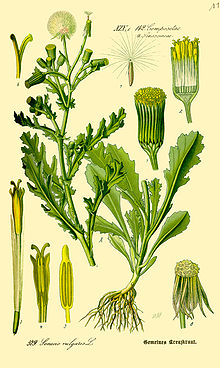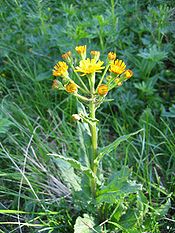Senecio
| Senecio | |
|---|---|

| |
| Senecio vulgaris, an illustration from 1885. | |
| Scientific classification | |
| Kingdom: | |
| (unranked): | |
| (unranked): | |
| (unranked): | |
| Order: | |
| Family: | |
| Subfamily: | |
| Tribe: | |
| Genus: | Senecio |
| Type species | |
| Senecio vulgaris L. | |
| Species | |
|
Some 1500, see text | |
| Synonyms | |
|
Dendrosenecio | |






Senecio (Template:Pron-en)[1] is a genus of the daisy family (Asteraceae) that includes ragworts and groundsels. The flower heads are normally rayed, completely yellow, and the heads are borne in branched clusters. Senecio is one of the largest genera of flowering plants, and despite the separation of many species into other genera it still contains over 1000 species of varied form, including leaf, stem and tuber succulents, annuals, perennials, aquatics, climbers, shrubs and small trees. Some species produce natural biocides (especially alkaloids) to deter or even kill animals that would eat them.
Senecio species are used as food plants by the larvae of some Lepidoptera species — see list of Lepidoptera that feed on Senecio.
Selected species
- Senecio ampullaceus — Texas ragwort, Texas squaw-weed, Texas groundsel, clasping-leaf groundsel[2]
- Senecio angulatus L.f. — Creeping groundsel
- Senecio antisanae
- Senecio arborescens
- Senecio aureus L. — Golden Ragwort[3]
- Packera aurea (L.) A. & D. Löve
- Senecio barbertonicus Klatt — Succulent Bush Senecio
- Senecio battiscombei
- Dendrosenecio battiscombei
- Senecio brasiliensis (Spreng.) Less. — flor-das-almas
- Cineraria brasiliensis
- Senecio cambrensis — Welsh groundsel, Welsh ragwort
- Senecio cineraria — Dusty miller
- Cineraria maritima
- Jacobaea maritima
- Othonna maritima
- Senecio congestus (R. Br.) DC. — Marsh ragwort, Clustered marsh ragwort, Marsh fleabane
- Cineraria palustris
- Othonna palustris
- Tephroseris palustris
- Senecio eboracensis Abbott & Lowe — York groundsel
- Senecio flaccidus Less. — Douglas senecio, threadleaf groundsel, threadleaf ragwort
- Senecio gallicus Chaix — Southern Ragwort
- Senecio glabellus Poir. — Butterweed
- Packera glabella (Poir) C. Jeffrey
- Senecio glaucus L. — Jaffa groundsel
- Senecio haworthii — woolly senecio
- Senecio iscoensis — Hieron.
- Senecio jacobaea — common ragwort, stinking willie, tansy ragwort;[4][5]
- synonymous with Jacobaea vulgaris
- Senecio keniensis
- Dendrosenecio keniensis
- Senecio keniodendron — Giant groundsel
- Dendrosenecio keniodendron
- Senecio keniophytum
- Senecio kleinia
- Kleinia neriifolia
- Senecio lamarckianus
- Senecio leucanthemifolius Poir. — Coastal Ragwort
- Senecio littoralis
- Senecio mikanioides — Cape Ivy, German Ivy
- Delairea odorata
- Senecio obovatus Muhl. — Roundleaf Ragwort
- Packera obovata (Muhl. ex Willd.)
- Senecio patagonicus
- Senecio pulcher
- Senecio rowleyanus — String of pearls
- Senecio sanmarcosensis
- Senecio squalidus — Oxford ragwort
- Senecio vaginatus
- Senecio vernalis — Eastern groundsel
- Senecio viscosus — sticky ragwort
- Senecio vulgaris — common groundsel, old-man-in-the-spring
Formerly in Senecio
- Brachyglottis greyi (as S. greyi)
- Florist's Cineraria, Pericallis × hybrida (as S. cruentus)
- Rugelia nudicaulis — Rugels ragwort
Synonyms
The following genera contain species that are or have been included within Senecio.[6]
Probable synonyms:
- Antillanthus B. Nord.
- Barkleyanthus H. Rob. & Brettell
- Brachyglottis J. R. Forst. & G. Forst.[7]
- Canariothamnus B. Nord.
- Dauresia B. Nord. & Pelser
- Dendrophorbium C. Jeffrey
- Dendrosenecio (Hauman ex Hedberg) B. Nord. - Giant groundsels
- Dorobaea Cass.
- Dresslerothamnus H. Rob.
- Elekmania B. Nord.
- Herreranthus B. Nord.
- Hubertia Bory
- Iocenes B. Nord.
- Jacobaea Mill.
- Lasiocephalus Willd. ex Schltdl.
- Leonis B. Nord.
- Lundinia B. Nord.
- Mesogramma DC.
- Monticalia C. Jeffrey
- Nelsonianthus H. Rob. & Brettell
- Nesampelos B. Nord., nom. inval.
- Oldfeltia B. Nord. & Lundin
- Packera Á. Löve & D. Löve
- Pentacalia Cass.
- Pippenalia McVaugh
- Pittocaulon H. Rob. & Brettell
- Pojarkovia Askerova
- Psacaliopsis H. Rob. & Brettell
- Pseudogynoxys (Greenm.) Cabrera
- Pseudojacobaea (Hook. f.) R. Mathur
- Roldana La Llave
- Sinosenecio B. Nord.
- Synotis (C. B. Clarke) C. Jeffrey & Y. L. Chen
- Telanthophora H. Rob. & Brettell
- Tephroseris (Rchb.) Rchb.
- Zemisia B. Nord.[8]
References
- ^ Sunset Western Garden Book, 1995:606–607
- ^ Sean Claes (2007-04-16). "Proceed With Caution" (HTML). Kyle, Texas Daily Photo. Retrieved 2008-04-10.
- ^ Connecticut Botanical Society (November 13, 2005). "Golden Ragwort" (HTML). Connecticut Wildflowers. Retrieved 2008-02-09.
Golden Ragwort is one of three species of ragwort in Connecticut, all with similar flowers.
- ^ M. Grieve (1931). "Ragwort" (HTML). A Modern Herbal. © Copyright Protected 1995–2008 Botanical.com.
- ^ "Tansy Ragwort" (HTML). Written Findings of the State Noxious Weed Control Board. Washington State Department of Agriculture. Retrieved 2008-02-09.
- ^ Pelser, Pieter B. (2007). "An ITS phylogeny of tribe Senecioneae (Asteraceae) and a new delimitation of Senecio L." Taxon. 56 (4). International Association for Plant Taxonomy (IAPT): 1077–14E(-1062). Retrieved 2008-06-29.
{{cite journal}}: Unknown parameter|coauthors=ignored (|author=suggested) (help); Unknown parameter|month=ignored (help) - ^ Norton, D.A. (1986). "Recent changes in the names of New Zealand tree and shrub species" (PDF). New Zealand Journal of Forestry. 31: 39–40.
{{cite journal}}: Cite has empty unknown parameters:|coauthors=and|month=(help) - ^ Germplasm Resources Information Network (GRIN) (2007-05-04). "Genus: Senecio L." (HTML). Taxonomy for Plants. USDA, ARS, National Genetic Resources Program, National Germplasm Resources Laboratory, Beltsville, Maryland. Retrieved 2008-02-27.
External links
![]() Media related to Senecio at Wikimedia Commons
Media related to Senecio at Wikimedia Commons
- Natural Resources Conservation Service (NRCS). "PLANTS Profile, Senecio L." (HTML). The PLANTS Database. United States Department of Agriculture. Retrieved 2008-03-06.
- Germplasm Resources Information Network (GRIN) (2005-10-26). "Genus: Senecio L." (HTML). Taxonomy for Plants. USDA, ARS, National Genetic Resources Program, National Germplasm Resources Laboratory, Beltsville, Maryland. Retrieved 2008-03-06.
- Germplasm Resources Information Network (GRIN) (2005-10-26). "GRIN Species Records of Senecio" (HTML). Taxonomy for Plants. USDA, ARS, National Genetic Resources Program, National Germplasm Resources Laboratory, Beltsville, Maryland. Retrieved 2008-03-06.
- Integrated Taxonomic Information System Organization (ITIS) (20 December 2007). "Senecio L." (HTML). Integrated Taxonomic Information System on-line database. Retrieved 2008-02-23.
- Botanic Garden and Botanical Museum Berlin-Dahlem. "Details for: Senecio" (HTML). Euro+Med PlantBase. Freie Universität Berlin. Retrieved 2008-03-06.
- Missouri Botanical Garden (1753). "Seneco L." (HTML). Tropicos Nomenclatural Data Base. Retrieved 2008-03-27.
{{cite web}}: External link in|work= - Royal Botanic Garden Edinburgh. "Flora Europaea Search Results" (HTML). Retrieved 2008-03-06.
- Flora of Israel Online. "Search Results For 'senecio'" (HTML). Hebrew University of Jerusalem. Retrieved 2008-03-06.
- Jerusalem Botanical Gardens. "LIST OF ALL PLANTS NAMES -WITH PHOTO S" (HTML). Retrieved 2008-03-06.
- Flora of North America. "Family List: 215. Senecio Linnaeus". 20: 540, 541, 542, 543, 544, 545, 570, 615. Retrieved 2008-03-06.
{{cite journal}}: Cite journal requires|journal=(help) - Cyrille Chatelain, Laurent Gautier, Raoul Palese. "Senecio L." (HTML). African Flowering Plants Database. Conservatoire et Jardin botaniques de la Ville de Genève. Retrieved 2008-03-06.
{{cite web}}: CS1 maint: multiple names: authors list (link) - Instituto Darwinion. "Asteraceae" (PDF). Catálogo de las Plantas Vasculares de la República Argentina. II (in Spanish). Universidad de Buenos Aires. p. 255. Retrieved 2008-03-06.
- Helen Coleman, FloraBase: Flora of Western Australia (1997-06-18). "search term: Senecio" (HTML). Flora Descriptions. Government of Western Australia. Retrieved 2008-03-06.
- Landcare Research. "Senecio L." (HTML). Flora of New Zealand: Taxa. Landcare Research Allan Herbarium and New Zealand Plant Names Database. Retrieved 2008-04-01.
- "Search for:genus:Senecio" (HTML). Species Information. Calflora — 1700 Shattuck Ave. #198, Berkeley, CA 94709. Retrieved 2008-02-09.
- Flora of Chile. "Volume 4 Asteraceae Senecio L." 4. Retrieved 2008-03-06.
{{cite journal}}: Cite journal requires|journal=(help) - Dr. Richard Wunderlin or Dr. Bruce Hansen (2006). "Search Results For Search String: Senecio" (HTML). Atlas of Florida Vascular Plants. Institute for Systematic Botany. Retrieved 2008-03-06.
{{cite web}}: External link in|work= - "Asteraceae" (HTML). Primera página de la especie (in Spanish). Malezas de México. Retrieved 2008-03-06.
- PlantNET — The Plant Information Network System of Botanic Gardens Trust. "Search terms: Senecio" (HTML). Botanic Gardens Trust. Retrieved 2008-03-06.
{{cite web}}: External link in|publisher= - University of Wisconsin–Stevens Point. "Senecio L." (HTML). Robert W. Freckmann Herbarium. Retrieved 2008-03-06.
- Royal Horticultural Society. "RHS PLANT FINDER" (HTML). Retrieved 2008-03-06.
- Manual of Gardening (Second Edition) at Project Gutenberg
